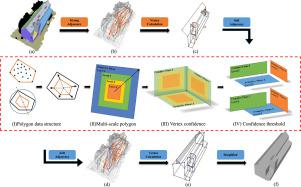ISPRS Journal of Photogrammetry and Remote Sensing ( IF 12.7 ) Pub Date : 2022-08-09 , DOI: 10.1016/j.isprsjprs.2022.07.024 Shengming Yang , Guorong Cai , Jing Du , Ping Chen , Jinhe Su , Yundong Wu , Zongyue Wang , Jonathan Li

|
Multi-view Stereo (MVS) meshes suffer from occlusions or missing data, making most surface reconstruction methods invalid. Due to data imperfections, existing methods, just like PolyFit, have made a trade-off between reconstruction accuracy and time consumption. We propose a novel approach that automatically reconstructs a building surface model from raw triangular mesh with data incompleteness. Unlike existing methods that extract high-quality primitives, our method focuses on assemblies of primitives to control the level of geometric detail in the reconstructed models. We design a topological relationship of the primitives to form a plane connection graph. To be precise, we first combine the scalability of shapes with plane primitives. Then strong and soft connections between primitives are constructed by calculating the confidence of the plane intersection in space. Furthermore, the topological relations of all primitives are encoded into an undirected graph. Finally, a watertight and manifold model is extracted from the faces of a candidate set by energy minimization. Experiments on the Helsinki 3D dataset demonstrate the superiority of our method in time consumption and reconstruction error, as measured by Hausdorff distance. Our method outperforms other primitive-based algorithms in handling non-planar structures. Even when dealing with imperfect data, a watertight model is still obtained.
中文翻译:

Connectivity-aware Graph:用于 3D 建筑表面重建的平面拓扑
多视图立体 (MVS) 网格会受到遮挡或丢失数据的影响,从而使大多数表面重建方法无效。由于数据不完善,现有的方法,就像 PolyFit 一样,在重建精度和时间消耗之间进行了权衡。我们提出了一种新颖的方法,可以从数据不完整的原始三角形网格中自动重建建筑表面模型。与提取高质量图元的现有方法不同,我们的方法侧重于图元的组装,以控制重建模型中的几何细节水平。我们设计图元的拓扑关系以形成平面连接图。准确地说,我们首先将形状的可扩展性与平面图元结合起来。然后通过计算平面相交在空间中的置信度来构建图元之间的强连接和软连接。此外,所有图元的拓扑关系都被编码成一个无向图。最后,通过能量最小化从候选集的面中提取出一个无懈可击的流形模型。赫尔辛基 3D 数据集上的实验证明了我们的方法在时间消耗和重建误差方面的优越性,由 Hausdorff 距离测量。我们的方法在处理非平面结构方面优于其他基于基元的算法。即使在处理不完善的数据时,仍然可以获得无懈可击的模型。通过能量最小化从候选集的面中提取出一个无懈可击的流形模型。赫尔辛基 3D 数据集上的实验证明了我们的方法在时间消耗和重建误差方面的优越性,由 Hausdorff 距离测量。我们的方法在处理非平面结构方面优于其他基于基元的算法。即使在处理不完善的数据时,仍然可以获得无懈可击的模型。通过能量最小化从候选集的面中提取出一个无懈可击的流形模型。赫尔辛基 3D 数据集上的实验证明了我们的方法在时间消耗和重建误差方面的优越性,由 Hausdorff 距离测量。我们的方法在处理非平面结构方面优于其他基于基元的算法。即使在处理不完善的数据时,仍然可以获得无懈可击的模型。



























 京公网安备 11010802027423号
京公网安备 11010802027423号